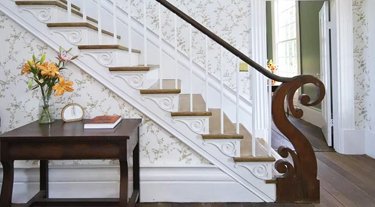Superb Newel Post by Thomas Day
Architecture, Design, Milton, North Carolina, Thomas Day
After some years of enjoying the festive social life of Virginia Hunt Country, Karen and I are finding the absence of society here at our farm in the Central Pennsylvania boondocks a little dull. Moreover, with old age comes arthritis and one feels the winter cold in the knees.
Despite my Northeastern Pennsylvania Coal Region origins, I have old-fashioned tastes and apparently a natural rapport with Virginia. When I arrived at Yale, a number of my classmates misspelled “David Zincavage” as “Davidson Cavidge,” having leapt to the conclusion based on the formality of my dress and manners that I was of Virginia gentry background.
A return to Old Virginia is tempting, but Occupied Virginia inside, and now sprawling over the beltway, loaded as it is with functionaries and bureaucrats all battening on the Federal purse, combined with the welfare class of the Commonwealth’s handful of large cities, recently successfully outvoted the natives and returned Virginia to a revolutionary Reconstruction regime run by Scallywags, Carpetbaggers, and African-American demagogues and mountebanks. I’m not sure my blood pressure would stand a closer proximity to Virginia politics. So we’ve been looking for an affordable very old, very large house (we have an enormous library) further South, hopefully in proximity to an organized fox hunt.
I came, last night, upon a really beautiful North Carolina house (in Milton) which is unfortunately too small, but which has really beautiful architectural detail apparently by a local free black cabinetmaker-woodworker. I think his newel post is a delightful piece of imaginative design. If you lived there, you’d smile every time you saw it.
Thomas Day (1801-1861) was a free black furniture craftsman and cabinetmaker in Milton, Caswell County, North Carolina. Born a free black man in Dinwiddie County, Virginia, Day moved to Milton in 1817 and became a highly successful businessman, boasting the largest and most productive workshop in the state during the 1850s. Day catered to high-class white clientele and was respected among his white peers for his craftsmanship and work ethic. Day came from a free and relatively well-off family and was privately educated. Today, Day’s pieces are highly sought after and sell for high prices; his work has been heavily studied and displayed in museums such as the North Carolina Museum of History. Day is heralded in modern society as an incredibly skilled craftsman and savvy businessman. …
With his furniture designs so popular and highly sought-after, it was no surprise that Day began to provide architectural work to homes in his region as well. In this architectural work, Day employed many of the same design motifs as in his furniture, playing again off his own interpretation of the Grecian/Greek Revival Style. For large plantation homes in the North Carolina and Virginia areas, Day provided mantle pieces, stair brackets and newel posts, and door frames among other architectural work. His work focused on symmetry, and he often incorporated similar or complementary designs in the newel posts and stair brackets to create a balance of design and to emphasize his furniture designs, since many homes he did architectural work for also boasted multiple furniture works by Day. As with his furniture designs, it appears that Day’s initial architectural designs stemmed from popular architectural pattern books; to these, Day would again add his personal design motifs to create unique products.
In his work on door frames, scholars agree that Day created both sidelights and transoms for interior doors in many homes he worked on. These architectural elements are characterized by the repetitive use of rectangular patterns. Day also often created newel posts for staircases, which he commonly designed utilizing s-curves and elongated scroll shapes, which represented Day’s interpretation of the traditional newel post; Day’s posts were both larger and longer than the classic Greek Revival Style posts, and are emphasized by the simplistic stair banisters that accompany them. As with his furniture, Day took the popular design of the newel post and added his own stylistic flair through his scroll curves. In crafting these newel posts, Day employed four different types of newels: s-shaped, traditional, a fusion of the two, or completely unique designs; today, twenty-five s-shaped newel posts have been attributed to Day. Day crafted stair brackets to match and complement these newel posts, again employing curvatures and wave motifs that, combined with the newel posts, suggested a tranquil fluidity.




